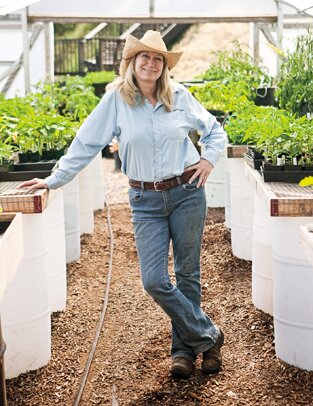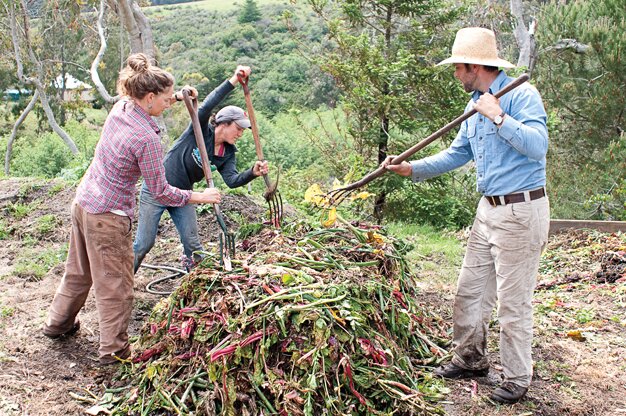Biodynamic Farming
Going Beyond Organic
Vine Hill Winery
Photographs by Lane Johnson
Potrero Nuevo Farm lies in the bucolic Tunitas Creek Valley of Half Moon Bay, one mile from the Pacific Ocean. The farm produces 50 different types of vegetables on a small section of its 300 acres, which includes an area reserved for wilderness. At first glance, Potrero Nuevo may not look much different from other large agricultural spreads on the San Mateo County coast, but this 4-year-old farm is run by a unique set of 90-year-old principles known as biodynamic farming.
Farm manager Seth James emphasizes that biodynamic farming is a “whole-farm system” that focuses on retaining the quality of the soil. A biodynamic farm generates all or most of its fertilizer on site, utilizing compost and manure. The farm always has its own animals for fertilizer production—preferably cows because of their superior manure. Biodynamic farms use nine specific preparations to stimulate microbial activities in the soil and compost. These range from horn manure and silica preparations to ones made from herbs such as yarrow, chamomile, and stinging nettle.
 “Once we started using the compost preparations, our compost was incredible,” James says. As a result, the produce at Potrero Nuevo increased in quality. “Our customers tell us we have the best strawberries, by far.”
“Once we started using the compost preparations, our compost was incredible,” James says. As a result, the produce at Potrero Nuevo increased in quality. “Our customers tell us we have the best strawberries, by far.”
The biodynamic farmer always saves seeds from crops grown on the farm in order to cultivate the varieties that grow best on that particular site. The farm operates under the guidance of a planting calendar, which includes specific details about which days are best for planting which crops.
“Biodynamics focuses on what’s positive,” James says. “It works with the rhythms of nature. It helps farmers get the most with the least effort.”
The principles of biodynamic farming were popularized in the 1920s by German philosopher and scientist Rudolf Steiner, best known as the founder of the Waldorf teaching philosophy. Steiner authored the book The Agriculture Course: The Birth of the Biodynamic Method in response to declining soil fertility throughout much of Europe. In the 1930s, Steiner’s assistant, Dr. Ehrenfried Pfeiffer, brought biodynamic practices to the United States. Today, a governing body, Demeter International, certifies biodynamic farms in 43 countries.
Organic farming and biodynamic farming share many principles, such as using no chemical pesticides, herbicides, or fertilizers. But biodynamic farming is not just concerned with the physical aspects of the farm. Landscaper and horticulturist Delmar McComb, garden curator at Saratoga’s Montalvo Art Center who is in charge of the estate’s 175 acres, says, “Biodynamics utilizes ancient wisdom, such as planetary phases. It’s an ongoing path to learning.” Planting by the moon and using the zodiac and the correlation between the planets, stars, moon, and earth, McComb says, is basic knowledge that farmers have used for eons. Farmer’s almanacs contain similar information.
 “There is a hidden world, a spiritual realm, that exists in nature… Biodynamic practices affect everything: soil, water, air, and plants. They enrich the atmosphere around the plants, as well as the plants,” says McComb. “If some of this sounds bizarre or unbelievable, ask yourself how rational it is to dump poisons on our food.”
“There is a hidden world, a spiritual realm, that exists in nature… Biodynamic practices affect everything: soil, water, air, and plants. They enrich the atmosphere around the plants, as well as the plants,” says McComb. “If some of this sounds bizarre or unbelievable, ask yourself how rational it is to dump poisons on our food.”
McComb adds that unlike with organic farming or traditional farming, with biodynamics “it can be hard to measure the results. We are used to the ‘weigh, count, and measure’ method. In biodynamics, it’s more like ‘levity, quality, and timing.’ ”
Cynthia Sandberg of Love Apple Farms in Santa Cruz says she can see and taste the results of biodynamic farming on her farm. “As far as I’m concerned, the evidence that biodynamics works is in the quality of what we grow here. Our produce tastes better and has improved nutritional value. This makes the people who eat it healthier, too.”
 On the site of a former vineyard once owned by the Smothers Brothers, Sandberg uses biodynamic practices to grow a variety of vegetables, including more than 100 varieties of heirloom tomatoes, with names like Amazon Chocolate and Nebraska Wedding. Her farm is the kitchen garden for Manresa restaurant in Los Gatos.
On the site of a former vineyard once owned by the Smothers Brothers, Sandberg uses biodynamic practices to grow a variety of vegetables, including more than 100 varieties of heirloom tomatoes, with names like Amazon Chocolate and Nebraska Wedding. Her farm is the kitchen garden for Manresa restaurant in Los Gatos.
Sandberg admits that it can be hard to keep up with the demands of biodynamic farming, and that it’s “an evolving process. Sometimes the calendar says we should plant carrots, but we’ve run out of time. So we do it the next day.”
The organic-certified Vine Hill Winery in Santa Cruz also utilizes biodynamic farming practices. Vineyard manager Rachel Ormes says, “Biodynamics is not meant to be taken as dogma. It is adaptable and flexible.” According to the rules of biodynamics, compost preparations are supposed to be stirred by hand for an hour. To save time, Ormes uses an elaborate water contraption that mimics the swirling, back-and-forth action of hand mixing “and gets the job done much faster.”
Ormes enjoys the ritualized aspect of biodynamic farming. “I love using the calendar and making the preparations. It helps me understand the rhythms of the earth and growing things,” she says.
Although Vine Hill lacks manure-producing animals, Ormes grows cover crops of barley, oats, peas, and insect-attracting flowers between the rows of grapevines. On alternate years, this lush carpet is turned under to fertilize the soil and prevent erosion, which is an ongoing concern at Vine Hill due to its steep, hillside location.
“Agriculture is exploitative,” Ormes says. “A farmer always needs to give back.”
Links to more information:
Vine Hill Winery
McComb Associates
Potrero Nuevo Farm
Seth James' recommendation
The text of Steiner's original lectures
Wikipedia: Rudolf Steiner
Wikipedia: Biodynamic agriculture
Click on the thumbnail images below to open a larger version of the photograph.
